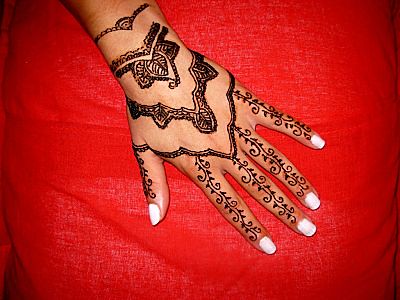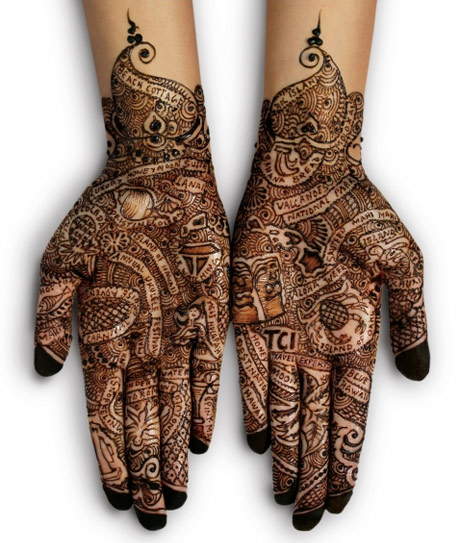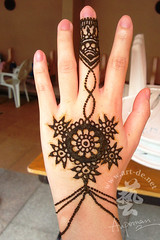Henna Hand Tattoos Biography
Source:- Google.com.pk
The art of henna (called mehndi in Hindi & Urdu) has been practiced for over Origin of Henna5000 years in Pakistan, India, Africa and the Middle East. There is some documentation that it is over 9000 years old. Because henna has natural cooling properties, people of the desert, for centuries, have been using henna to cool down their bodies. They make a paste of henna and soak their palms and soles of the feet in it to get an air conditioning affect. They feel its cooling sensation throughout the body for as long as the henna stain remains on their skin. Initially, as the stain faded away, it left patterns on the skin surface which led to ideas to make designs for decorative purposes. In the ancient Egyptian times mummies wore henna designs and it is documented that Cleopatra herself used henna for decorative purposes.
Henna was not only a popular adornment for the rich but the poor, who could not afford jewelry, used it to decorate their bodies as well.
Henna in the West
Today people all over the world have adopted the ancient traditions of adorning their bodies with the beautiful natural artwork created from the henna plant. It became a very popular form of temporary body decoration in the 90's in the US and has become a growing trend ever since. Celebrities like Madonna, Gwen Stefani, Yasmine Bleeth, Liv Tyler, Xena, and many others proudly adorn their bodies with henna and show them off in public, movies, videos, etc. People throughout the west have adopted the eastern tradition in their lives by having their hands and feet painted for weddings, bellies painted while in pregnancy, heads adorned with henna while going through chemotherapy, scars camouflaged to make them unnoticeable, etc.
Cultural & Medicinal Uses
Henna is used for many reasons including: self-expression; celebration of special occasions like weddings, holidays & birthdays; inspiration; reminders; beauty; cosmetic treatments; medicinal uses; blessings & well-being; to be part of an ancient tradition; and an alternative or precursor to a tattoo.
The Henna Plant
Henna, scientifically named Lawsonia Inermis, is a shrub that grows up to 12 feetHenna Plant high. It can be found in the hot climates like Egypt, Pakistan, India, Africa, Morocco, and Australia. The plant grows best in heat up to 120F degrees and contains more dye at these temperatures. It wilts in temperatures below 50F degrees. It also grows better in dry soil than damp soil. The leaves are in opposite decussate pairs and vary in sizes from approximately 2-4 cm. long. The flowers are fragrant, produced in conical panicles 1040 cm long, each flower 5 mm diameter, with four white petals. The fruit is a dry capsule 68 mm diameter, containing numerous 12.5 mm seeds.
The henna plant contains lawsone which is a reddish-orange dye that binds to the keratin (a protein) in our skin and safely stains the skin. The stain can be from pale orange to nearly black depending on the quality of the henna and how well ones skin takes it. A good henna, fresh from hot & dry climates, will stain the darkest.


Henna was not only a popular adornment for the rich but the poor, who could not afford jewelry, used it to decorate their bodies as well.
Henna in the West
Today people all over the world have adopted the ancient traditions of adorning their bodies with the beautiful natural artwork created from the henna plant. It became a very popular form of temporary body decoration in the 90's in the US and has become a growing trend ever since. Celebrities like Madonna, Gwen Stefani, Yasmine Bleeth, Liv Tyler, Xena, and many others proudly adorn their bodies with henna and show them off in public, movies, videos, etc. People throughout the west have adopted the eastern tradition in their lives by having their hands and feet painted for weddings, bellies painted while in pregnancy, heads adorned with henna while going through chemotherapy, scars camouflaged to make them unnoticeable, etc.
Cultural & Medicinal Uses
Henna is used for many reasons including: self-expression; celebration of special occasions like weddings, holidays & birthdays; inspiration; reminders; beauty; cosmetic treatments; medicinal uses; blessings & well-being; to be part of an ancient tradition; and an alternative or precursor to a tattoo.
The Henna Plant
Henna, scientifically named Lawsonia Inermis, is a shrub that grows up to 12 feetHenna Plant high. It can be found in the hot climates like Egypt, Pakistan, India, Africa, Morocco, and Australia. The plant grows best in heat up to 120F degrees and contains more dye at these temperatures. It wilts in temperatures below 50F degrees. It also grows better in dry soil than damp soil. The leaves are in opposite decussate pairs and vary in sizes from approximately 2-4 cm. long. The flowers are fragrant, produced in conical panicles 1040 cm long, each flower 5 mm diameter, with four white petals. The fruit is a dry capsule 68 mm diameter, containing numerous 12.5 mm seeds.
The henna plant contains lawsone which is a reddish-orange dye that binds to the keratin (a protein) in our skin and safely stains the skin. The stain can be from pale orange to nearly black depending on the quality of the henna and how well ones skin takes it. A good henna, fresh from hot & dry climates, will stain the darkest.
Henna Hand Tattoos For Girls For Women Tumble Words Quotes For Men Design Designs Writing

Henna Hand Tattoos For Girls For Women Tumble Words Quotes For Men Design Designs Writing

Henna Hand Tattoos For Girls For Women Tumble Words Quotes For Men Design Designs Writing

Henna Hand Tattoos For Girls For Women Tumble Words Quotes For Men Design Designs Writing

Henna Hand Tattoo For Girls For Women Tumble Words Quotes For Men Design Designs Writing

Henna Hand Tattoos For Girls For Women Tumble Words Quotes For Men Design Designs Writing

Henna Hand Tattoos For Girls For Women Tumble Words Quotes For Men Design Designs Writing

Henna Hand Tattoos For Girls For Women Tumble Words Quotes For Men Design Designs Writing

Henna Hand Tattoos For Girls For Women Tumble Words Quotes For Men Design Designs Writing

Henna Hand Tattoos For Girls For Women Tumble Words Quotes For Men Design Designs Writing

Henna Hand Tattoos For Girls For Women Tumble Words Quotes For Men Design Designs Writing
No comments:
Post a Comment